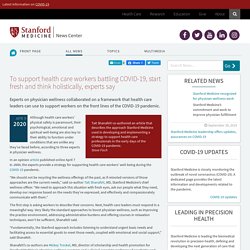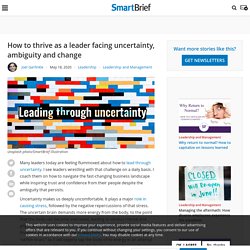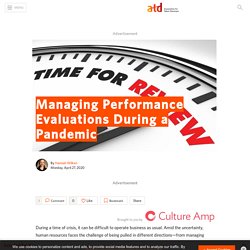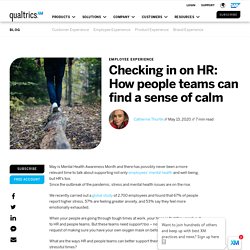

The Impact Of The Coronavirus On HR And The New Normal Of Work. For the past decade I have been writing and speaking about the disruptions in the way we work, learn and communicate.

In my article, Humans, Gigs and Robots Are The New Blended Workforce, I saw an increase in full time workers working side by side with gig workers and bots or digital assistants. I went on to say: the pace of change has never been this fast, yet it will never be this slow again! What I did not envision is we would be working exclusively from our homes while juggling home schooling and trying to figure out how to conduct three Zoom sessions at the same time: one for our own meeting, one for our spouse or partner’s meeting, and one for our child learning at home! The Covid-19 coronavirus is becoming the accelerator for one of the greatest workplace transformations of our lifetime.
How we work, exercise, shop, learn, communicate, and of course, where we work, will be changed forever! 1) Ramp up Training and Investment in Remote Working Microsoft is going one step further. How To Find Direction Amid Uncertainty And Change. This is the final installment in a four-part series on Purpose During A Pandemic.

Part 1 covered why purpose is important for keeping us healthy, Part 2 investigated the difference between purpose and productivity, and Part 3 explored how we can find purpose by making the most of the disruptions we’re facing. This final portion discusses where and how we can find direction when everything around us is shifting. There’s no denying that we’re in a period of extreme disruption.
Between a pandemic, boiling outrage over racial inequalities, and sky-high unemployment rates, uncertainty is our new normal - and it’s affecting all of us. “We’re all vulnerable,” wrote Senior Economics Correspondent Neil Irwin in The New York Times while analyzing recent unemployment trends, “whether we work in an office or a factory or a construction site; whether our employer is public or private; whether our work can easily be migrated to a home office or not.”
Leading Through COVID-19: 4 Strategies to Inspire and Motivate. This is part four of our multi-part blog and video series, Leading Teams in Times of Crisis and Immense Change.

During these challenging times, staff are experiencing high levels of change, resulting in increased levels of stress and anxiety. To support health care workers battling COVID-19, start fresh and think holistically, experts say. Although health care workers’ physical safety is paramount, their psychological, emotional and spiritual well-being are also key to their ability to function under conditions that are unlike any they’ve faced before, according to three experts in physician wellness.

In an opinion article published online April 7 in JAMA, the experts provide a strategy for supporting health care workers’ well-being during the COVID-19 pandemic. “We should not be recycling the wellness offerings of the past, as if retooled versions of those approaches are the current needs,” said co-author Tait Shanafelt, MD, Stanford Medicine’s chief wellness officer. “We need to approach this situation with fresh eyes, ask our people what they need, develop our response based on the needs they’ve expressed, and effectively and compassionately communicate with them.”
The first step is asking workers to describe their concerns. Next, health care leaders must respond in a meaningful way. Developing the Stanford framework. What Healthcare Workers Need From Leaders in COVID-19 Crisis. Story Highlights Data show healthcare workers need more support from leadershipFocus on transparent communication, innovation and wellbeingLeaders can facilitate their employees' success.

How to thrive as a leader facing uncertainty, ambiguity and change. Many leaders today are feeling flummoxed about how to lead through uncertainty.

I see leaders wrestling with that challenge on a daily basis. How to thrive as a leader facing uncertainty, ambiguity and change. How Healthcare Workers Will Respond to Coronavirus Depends on Us. David Shulkin, M.D.

FACP, Ninth Secretary, US Department of Veteran Affairs – in collaboration with Wambi - Thursday, April 2nd, 2020 Print | Email With the coronavirus (COVID-19) actively spreading, and so many uncertainties about its course, it may seem we are in unchartered territory. The declaration of a national emergency at both state and federal levels has clearly focused attention on the readiness of our medical infrastructure and workforce. While the COVID-19 virus is novel, there is still much we can learn from prior infectious outbreaks. It is crucial to note that the spread of viral illness depends on a number of factors such as the virulence of the pathogen, adherence to public health precautions and measures, and the readiness of the healthcare system. In the 1918 influenza pandemic, hospitals overflowed. Stress on nurses, physicians and others dealing with the 1918 pandemic was considerable. Make Staff Safety and Health Paramount.
Managing Performance Evaluations During a Pandemic. During a time of crisis, it can be difficult to operate business as usual.

Amid the uncertainty, human resources faces the challenge of being pulled in different directions—from managing communications and crisis response planning to maintaining some level of business continuity. As the Society for Human Resource Management (SHRM) suggests, it’s critical for organizations to aim to manage operations with minimal loss and disruption to the normal business flow.
How People Teams Can Find a Sense of Calm. May is Mental Health Awareness Month and there has possibly never been a more relevant time to talk about supporting not only employees' mental health and well-being, but HR’s too.

Since the outbreak of the pandemic, stress and mental health issues are on the rise. We recently carried out a global study of 2,700 employees and found that 67% of people report higher stress, 57% are feeling greater anxiety, and 53% say they feel more emotionally exhausted. When your people are going through tough times at work, your hope is that they reach out to HR and people teams. But these teams need support too – not unlike the airline request of making sure you have your own oxygen mask on before helping others. Struggling to keep staff up-to-date? Use these 5 e-communication channels. Inspirational quotes to get us through the coronavirus shutdown. These are the kinds of pithy, inspiring phrases and quotes that, historically speaking, have the power to steady us through challenging times.

War. Depression. The 1980s. Call them mantras, maxims or even memes -- they get repeated and recycled over the years, sometimes over the millennia, because they contain powerful jolts of easily accessible truth, insight and perspective. I've been collecting such fun-size, self-contained wisdom for decades now. 5 Easy Ways to Give Your Employees Emotional Support During Difficult Times (Like Now) If you are anything like me, you probably think you are doing just fine in the midst of this COVID-19 crisis. Yes, it’s scary and unsettling…but I can handle a lot and while it is stressful – I’m doing just fine. Just ask anyone…except maybe my son, who saw me get scratchy with him for a teasing comment he made.
Also, don’t ask my co-worker who wrote an email providing constructive feedback that I took personally. And don’t ask my significant other who saw me burst into tears after listening to a song on the radio. (It wasn’t just any song…it was a country song about dying…who wouldn’t cry, right?) Maybe you are seeing others around you react and behave in uncommon ways too: How to Deliver a Town Hall Presentation During Times of Uncertainty. Town hall presentaiton hosted by hcg. Inspirational quotes to get us through the coronavirus shutdown. How Humor Can Be A Leader’s Friend In A Crisis. There’s an old show business adage that seems perfect for our times. “Life is easy,” goes the saying. “Comedy is hard.” And so when I connected with Trevor Smith, who bills himself as Certified Laughter Leader of the World Laughter Tour, Inc., I knew he would have some good advice for leaders dealing with the hard times of the COVID-19 pandemic.
Emotional Intelligence (EQ) Tests, Training, Certification & Coaching - TalentSmart. We’ve all received the well-meaning advice to “stay positive.” The greater the challenge, the more this glass-half-full wisdom can come across as Pollyannaish and unrealistic. How Managers Can Protect Their Team From Burnout During Coronavirus. Listen to the audio newscast of this article: As millions of employees around the world are figuring out how to work from home in the middle of the coronavirus crisis, the need for effective people managers has become crystallized.
People are desperately looking to their bosses for guidance and support — over 80% of respondents in a Thrive Global original survey of over 5,000 people say that they wish their employer did more to help them manage their stress and anxiety due to the coronavirus outbreak. Meanwhile, many managers — even the strongest ones — are learning the ropes of good leadership all over again. 5 Easy Ways to Give Your Employees Emotional Support During Difficult Times (Like Now) How to Deliver a Town Hall Presentation During Times of Uncertainty. How to Deliver a Town Hall Presentation During Times of Uncertainty - Human Capital Growth. KF Leadership Playbook Global MH V14. How to help an employee or colleague panicked by coronavirus - HRM online. Two months ago I felt that people worried about coronavirus seriously affecting Australia were overly anxious. Two weeks ago I thought people stockpiling in preparation for quarantine were panicking. I no longer think either of those things.
7 Steps to Stop Finger-Pointing in a Crisis. Today’s question for Ask the Coach: After any crisis — like the economic crisis we now experiencing — there is a lot of finger-pointing. How to Make Your Teams Stronger in a Crisis. The way corporate teams work together has evolved in recent years, moving from top-down and expertise-driven to an approach built around cocreating and purpose. How to Support Your Team During a Crisis. A crisis can be defined in a variety of ways. It can be something that takes place in the workplace itself, occurs in the life of an employee or coworker, be the result of a major weather event, or be part of a larger disruptive global or national narrative. Regardless of the reason, major critical events in the workplace require delicate leadership, not management, to maintain effective employees and morale. In addition to navigating and responding to the actual crisis you may be facing as a team, you also need to carefully consider internal communications as a form of resolution.
5 Ways to Keep Your Employees Happy During a Crisis. It's not easy being a business owner or a manager. How to lead in times of crisis. Leading Your People in Times of Crisis. How to Keep Morale High During Challenging Times. By David Lee an earlier version of this was published in the Portland Press Herald While commonsense says keeping morale high during challenging times is both difficult and important, /Research by Watson Wyatt Worldwide has shown the importance of keeping employees engaged during difficult times.
They found that companies with high employee engagement levels enjoyed 200% greater profits during difficult economic times than those who had disengaged employees. A Time to Lead with Purpose and Humanity. Leading through Isolation: Part 1. A Time to Lead with Purpose and Humanity.